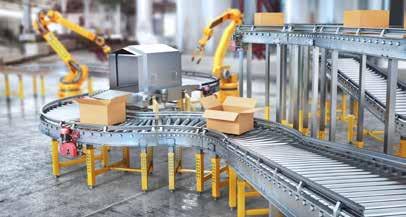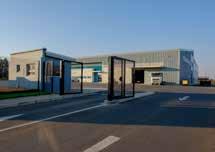
7 minute read
INDUSTRIAL PROPERTY DEVELOPMENT
The rise and rise of e-commerce
From a change in demand driven by the growth of e-commerce, the profile of the industrial property industry is evolving. LISA WITEPSKI rounds up the trends
REIT’s Louwlardia Logistics Park
E-commerce has traditionally accounted for just 1-2 per cent of retail sales - but that’s set to change, growing to up to 3 per cent or even 5 per cent, thanks to COVID-19’s impact, according to Ridwaan Loonat, property analyst at Nedbank CIB. In fact, Loonat says that Prologis puts this number closer to 20 per cent.
The ramifications are significant: with e-commerce taking up three times the space that a bricks-and-mortar store would need per dollar of sales, it’s clear that demand for distribution centres and urban warehouses is set to grow.
The change is already taking place, says Steven Brown, CEO of Fortress REIT, reporting that the company’s vacancies in the logistics space is in the low digits, while Bruce Fields, national director of JLL, says that one national retailer has reported a 200 per cent online boom, thanks to COVID-19. “The increase in e-commerce adoption, particularly for food, fast-moving consumer goods, pharma and health-related products should support demand for modern logistic real estate.”
In addition, overflow space has also been required as a result of the need to create contingency in the supply of goods due to the impact of COVID-19. Surges in demand for certain goods, as recently experienced due to the pandemic, may require a rethink of certain supply-chain management aspects as suppliers may seek to bolster supply of certain highdemand goods.”
Fields adds that despite the wide range of industries making use of logistics real estate, the disruption to brick-and-mortar retail - and on logistics supply space in particular - is likely to be limited, because consumer spend is expected to remain subdued in the short- to medium-term. That said, there is likely to be greater demand for logistics centres suited to meeting the needs of the e-commerce market Bruce Fields in terms of location and design, especially given the growing demands on delivery timelines as the national footprint for key e-commerce service providers continues to develop.
Steven Brown “The increase in e-commerce adoption, particularly for food, fast-moving consumer goods, pharma and health-related products should support demand for modern logistic real estate.” – Steven Brown, CEO, Fortress REIT
Warehouse design is changing to accommodate the new demand on the sector.

Warehouse design
SIZE MATTERS
Warehousing design is changing on two levels: on the one hand, there’s a growing demand for bigger, mega-distribution centres capable of serving an entire network, according to Corne van Rooyen, head of industrial, commercial, education, hospitality and mixed-use property at Fernridge Solutions.
“But changes are unlikely to be immediate: the planning, design and construction of additional warehouses and logistics takes time, so many local retailers ›
are offering these services from their existing store, warehouse and logistics networks,” says van Rooyen.
Demand is changing in other ways, too. Inospace’s Rael Levitt agrees that larger distribution centres - measuring 10 000m 2 or more - are increasingly attractive, adding that these are often customised with significant height to allow for packing and stacking, or large access areas to facilitate trucking.
Mid-size companies, meanwhile, are moving away from incorporating office space within warehouses, leaving more floor space open. This represents an effort to avoid the considerable expense of automated racking spaces. Levitt has also noticed increased interest in smaller spaces, measuring around 500 to 5 000m 2 .
One of the biggest issues driving changes in design is accessibility, according to Paul Cook, CEO of Faithful to Nature. Cook observes that the days of warehouses storing large quantities in trajectory is very much in evidence when it comes to demand for flexible leasing. Paul Cook, CEO of Faithful to Nature, points out that most e-commerce businesses are typically fast-growing and venture funded, making capital expensive. Added to this, few entities in this space can predict their needs within the next five years, making it hard to know what kind
Automation infrastructure in warehousing helps maintain spacing flexibility.
bulk are over, which means that they will no longer be required to accommodate enormous trucks. Instead, the focus will shift to improving access for small vehicles and fleets; thus, the very shape of the warehouses will change.
TECHNOLOGY AND DESIGN
“Facilities will need to be able to accommodate higher tech working, from the point of view of infrastructure as well as an environment that is increasingly of space they will require. Consequently, there is understandable reluctance to sign long-term leases.
However, even better-established businesses can expect a state of flux in the wake of the pandemic, says Marc Levitt of Paragon Lending Solutions. “We’re seeing a definite move away from traditional, longer leases of say five years, to shorter leases of one to two years.
Paul And even more optionality
Cook around opportunities to

called upon to support machine vision, robotics and automation.”
Finally, says Hannes Wagner of Struxit Projects, anyone considering warehouse design should give thought to implementing infrastructure technology which enhances automation possibilities, installation and process time, and lean manufacturing best processes. The ideal warehouse space is flexible, so that it can be tweaked by future lessees,
Companies look for high quality, flexible spaces from trusted operators.
Flexibility: The leasing model of the future

The impact of e-commerce’s upward
if necessary. expand your workspace during busy times or decrease it (with a penalty), as cycles demand.”
Levitt adds that this trend is affecting the dynamic between tenants and landlords, with the former assuming more power - to the point where they are able to dictate what they are willing or able to pay.
Corne van Rooyen, head of industrial, commercial, education, hospitality and mixed-use property at Fernridge Solutions, agrees, noting that this new flexibility is not limited to the industrial property sphere but can be seen in all sectors - and it has consequences. “If landlords don’t grant tenants the flexibility they need, in terms of space or lease-terms, they’re likely to approach thirdparty logistics or storage providers that are able to meet their needs. Landlords and tenants alike therefore have to adopt an adaptive mindset if they are to balance factors such as tenant retention, rental
escalation, space requirements and lease options.”
These developments are taking place against a backdrop of increased flexibility in all aspects of the organisational milieu, says Grant Kirchmann, head of corporate solutions SA & SSA at JLL. He points to the adoption of remote-working practices, but this trend goes beyond a need for flexible space. For instance, he forecasts a reversal of the densification trend which was prevalent over the past years, as companies place new emphasis on health and safety.
Kirchmann maintains that this will give rise to small, more efficient markets populated by well financed, profitable regional operators as companies look for high quality, flexible space from trusted operators.
We may even see the entry of remote warehouse facilities based on the model of remote offices spaces, such as WeWork.
“If landlords don’t grant tenants the flexibility they need, in terms of space or lease-terms, they’re likely to approach third-party logistics or storage providers.” – Corne van Rooyen, Fernridge Solutions
When Inospace introduced their “Pay-as-you-go” leasing option, they immediately got interest from many of South Africa’s largest retailers and groups who needed immediate space for both slow and fast-moving goods. These companies were not interested in signing lengthy long-term leases.
Traditionally, Inospace focused on small-and medium-term businesses but they also knew that all businesses would want the type of month-tomonth warehousing solutions that they could offer. Looking ahead, they believe that large businesses and corporates will also start utilising on-demand warehousing to place stock which has traditionally moved through more expensive retail channels.
Nairobi Gate Industrial Park, located off the eastern bypass in Nairobi.
Location, location

While other aspects of the industrial property sector may be undergoing significant transformation, demand for space in terms of regionality remains predictable: Johannesburg, Cape Town and Durban have the existing networks and established markets to ensure that large mega-distribution centres in these areas remain highly sought after, says Van Rooyen. He cites Cato Ridge and Hammarsdale in Durban as examples of areas that have experienced significant recent growth, driven by these factors.
But, he continues, companies will increasingly look at smart geo-location analysis to optimise the location of smaller regional distribution and pick-up centres, to reduce the time and distance of lastmile delivery so that same-day delivery becomes the norm. These centres are usually located on the edge of urban areas - Plumstead in Cape Town, Umhlanga in Durban and Fourways in Johannesburg are prime examples.
Some companies, meanwhile, are looking beyond South Africa’s borders to take advantage of industries that, unlike our own, have yet to become saturated. For instance, Mark Truscott of Improvon
York Commercial Park, Lusaka

reports that the company’s Nairobi Gate has been well received by a Kenyan industry eager to enjoy the conveniences of a world-class industrial park, while York Commercial Park in Zambia is set to offer that country similar benefits.







